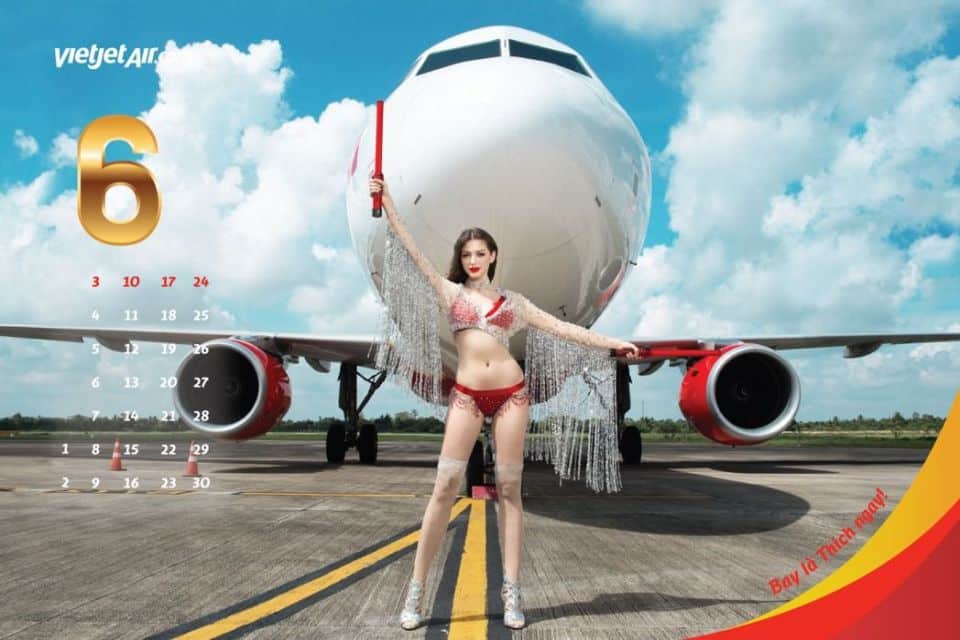Aviation
Vietnamese airline’s 2018 bikini calendar may set pulses racing

HANOI/SINGAPORE according to Reuters – Vietnam’s VietJet Aviation said on Thursday it was standing by a controversial “bikini” calendar, a marketing ploy featuring scantily clad female models that has prompted criticism in conservative Southeast Asia and beyond.
The annual calendar, which has gone viral online, is part of a broader marketing push by VietJet that has propelled the start-up airline’s rapid growth, as it has taken market share from Vietnam Airlines.

The publication of the 2018 calendar – which critics say overly sexualizes the image of flight attendants and other airline staff – comes as there is a growing debate in the global airlines industry about sexual harassment and in-flight assault of both passengers and employees.
VietJet, founded by Nguyen Thi Phuong Thao – Vietnam’s first female billionaire and one of a handful of women running a major airline globally – said the calendar emphasized free choice of people to wear whatever they wanted.

“We are not upset when people associate us with the bikini image. If that makes people delighted and happy, then we’ll be happy,” Luu Duc Khanh, VietJet’s managing director, said in emailed comments to Reuters.
When asked about the views of Thao, Khanh said the CEO thought people “have the right to wear whatever they like, bikini or traditional ao dai”, referring to the traditional Vietnamese long dress.

The calendar has caused an online storm in Vietnam, with some people criticizing and others defending the campaign. The 2018 calendar and a YouTube video of the photo shoot have been viewed more than 910,000 times since first appearing at the end of last month.
“I think (the calendar) is beautiful, not unpleasant at all,” one user posted on Facebook under the avatar Mai Co. Another person, named as Van Nhi, said the airline was “creating scandal to gain attention. It’s getting more unpleasant.”
Critics say VietJet’s risqué marketing, including the calendar and bikini fashion shows on board planes, presented an archaic and sexist image of cabin crew, even as the risk of harassment and assault go widely underreported.
VietJet is “taking us back 50 years by hyper-sexualizing a female dominated work group in order to make a few bucks off a couple of cheesy calendars,” said Heather Poole, a veteran U.S. flight attendant and author of a book about working the not-always-friendly skies.

Aviation
Boeing, Antonov to Collaborate on Defense Projects

– MOU represents Boeing’s commitment to work with Ukrainian industry
– Includes exploring opportunities for collaborating on in-country support of Unmanned Aerial Systems
A Memorandum of Understanding was signed today by Boeing and Antonov Company to investigate potential collaboration on defense-related projects.
“We’re happy to keep collaborating with the Antonov Company to help Ukraine’s economic development and expansion,” stated Ted Colbert, CEO and president of Boeing Defence, Space, & Security.
Airbus and the Antonov An-225: The Best Partnership:Click here
“This agreement demonstrates our ongoing efforts to find more opportunities to work with Ukrainian industry, which was underscored by our signing of the Ukrainian Defence Industry Compact earlier this year.”
The areas of potential collaboration identified in the agreement consist of training, logistical support and overhaul services for tactical Unmanned Aerial Systems utilized by the Ukrainian Armed Forces, which includes the ScanEagle. In addition, the companies will also explore opportunities for Antonov to provide engineering support to Boeing.
The six largest cargo aircraft ever built in the aviation industry:Click here
“A strong, innovative, and efficient defense industry is key to sustainable economic development and national security, and we are extremely excited to collaborate with Boeing,” said Ievhen Gavrylov, CEO of Antonov Company.
This agreement brings a whole new level of opportunity to implement the latest and most effective solutions – in addition to the possibility of future projects with Boeing in the aerospace and defense industry.”
-

 Travel1 week ago
Travel1 week agoAir India to Expand US Operations with Three New Routes After a Decade
-

 Travel2 weeks ago
Travel2 weeks agoWhy We Should Avoid These Stamps in a Passport
-

 Airlines1 month ago
Airlines1 month agoInvestigations Reveal Fake Chinese Titanium in Boeing and Airbus Jets
-

 Tech4 weeks ago
Tech4 weeks agoChina’s CATL Plans 1,800-Mile Electric Plane Launch by 2027
-

 Airport3 days ago
Airport3 days agoTop 10 Largest Airports in the World by Size
-

 Aerospace4 weeks ago
Aerospace4 weeks agoChina’s Fighter Jets Turn Wings into Autonomous Drones
-

 Airlines4 days ago
Airlines4 days agoAir India Rolls Out A350s for Delhi-New York JFK and Newark Routes
-

 Defence3 weeks ago
Defence3 weeks agoBoeing Enhances Chinook with New Engines and Block II Upgrades at $96 Million







